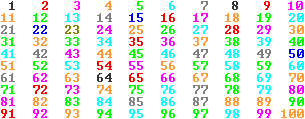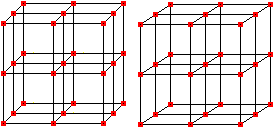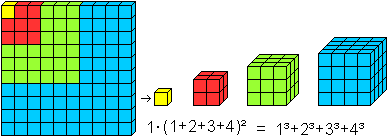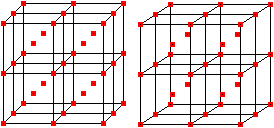What is a cube number?
On the other hand a cube number results by multiplying an integer by itself three times. Formula: a*a*a=a³=k (a and k stand for integers.) The same factor is called the base. After this a negative number like (-2)³= -8 or a fraction number like (2/3)³=8/27 are suspended. If it is appropriate, the number 0 is also a cubic number. These are the first 100 cube numbers. 
If a is the side of a cube, the volume is a³.
Cube Root top
1 Computation with the calculator In former times you found cube numbers by ready-reckoners, today there are calculators. You act with the TI30 like this: After entering the number you press the keys yx , (1/3) and finally = . Example: [2299968] -- [yx] -- [(1/3)] -- [=] . You get 22999681/3 =132. It is even simpler to give in 2299968^(1/3) into the searching field of Google or Bing. The cube root appears after pressing the enter key. 2 Determination by nested intervals 22999681/3 The number must be between 100 and 200 (100³=1000000 and 200³=4000000). It must be between 130 and 140 (130³=2197000 and 140³=2744000). It must be near 130 and 8 is on the ones place. Then 132 comes into consideration. Result: 22999681/3=132 3 Determination by factorization 22999681/3 You write the number in factors and develop the cube number this way. 2299968 = 8*287496 = 8*27*10648 = 8*27*8*1331=8*27*8*11*121=8*8*27*11³=(2*2*3*11)³=132. Result: 22999681/3 = 132. Cube
Roots of Negative Numbers? top
This is possible. The equation (-2)³=-8 is changed to -(81/3)=-2. Generally x³=a leads to x=-(-a)1/3 for a<0. Sequences and Series
top
Proof by mathematical induction >The statement holds for n=1:
s1=[1*(1+1)/2]²=1.
Interpretation as an arithmetic series of third order The sequence of the cube numbers is also an arithmetic series of third order. A figure follows to explain this.  The feature is that you reach a constant difference 6 after three steps. There are formulas for these sequences, so that you can prove the formula 1³+2³+3³+...+n³=[n(n+1)/2]² in another way. You can read this on Steffen Weber's (URL below) German web site. Series of odd numbers There is 1³=1, 2³=3+5, 3³=7+9+11, 4³=13+15+17+19, ... and 1³+2³+3³+4³+... = 1+3+5+7+9+11+13+15+17+19+... Series of the reciprocal cube numbers There is another series of cube numbers, the one of the reciprocal cube numbers: 1/1³+1/2³+1/3³+...+1/n³. It is convergent. You find the limit, the Riemann's zeta-function for 3, on the Wikipedia page 1729 (number). Series of the centered hexagonal numbers The sequence of the centered hexagonal numbers is 1, 7, 19, 37, 61, 91, 127, 169, 217, 271, 331, ...  There is 1, 1+7=8, 1+7+19=27, 1+7+19+37=64, ... The series to the sequence of the centered hexagonal numbers is the sequence of the cube numbers. Calculation for proving: 
The formulas 1²+2²+3³+...+n²=(1/6)n(n+1)(2n+1) and 1+2+3+...+n=(1/2)n(n+1) are used. Sequence of the centered cube numbers The sequence of the centered cube numbers is 1, 9, 35, 91, 189, 341, 559, 855, 1241,...
The formula is an=2n³-3n²+3n-1.
Atomium in Brussels, a centered cube
Sequence of the perfect numbers T.L. Heath (1861-1940) proved that every even perfect number - except 6 - is the sum of 2(n-1)/2 cube numbers, for example 28=1³+3³, 496=1³+3³+5³+7³, 8128=1³+3³+5³+7³+9³+11³+13³+15³. Source (3), page 14f. Waring's
Problem
top
That means that 9 is a smallest number. It can be more than 9 as the following sum of 180³ with 64 (!) cubic numbers shows. 180³ = 6³+7³+8³+...+67³+68³+69³ (1). Already 4 summands will do, 180=1³+3³+3³+5³. The first numbers 1=1³ 2=1³+1³ 3=1³+1³+1³ 4=1³+1³+1³+1³ 5=1³+1³+1³+1³+1³ 6=1³+1³+1³+1³+1³+1³ 7=1³+1³+1³+1³+1³+1³+1³ 15=2³+1³+1³+1³+1³+1³+1³+1³ 23=2³+2³+1³+1³+1³+1³+1³+1³+1³ Dissection of the numbers <= 100, found by a simple computer program The smallest number of the summands is determined. >The numbers 2, 9, 16, 28, 35, 54, 65, 72, 91 have sums with 2 cubes at least: 2, 9, 16, 28, 35, 54, 65, 72, 91 >Sums with 3 cubes: 3, 10, 17, 24, 29, 36, 43, 55, 62, 66, 73, 80, 81, 92, 99 >Sums with 4 cubes:4, 11, 18, 25, 30, 32, 37, 44, 51, 56, 63, 67, 70, 74, 82, 88, 89, 93, 100 >Sums with 5 cubes: 5, 12, 19, 26, 31, 33, 38, 40, 45, 52, 57, 59, 68, 71, 75, 78, 83, 90, 94, 96, 97 >Sums with 6 cubes: 6, 13, 20, 27, 34, 39, 41, 46, 48, 53, 58, 60, 69, 76, 79, 84, 86, 95, 98 >Sums with 7 cubes: 7, 14, 21, 42, 47, 49, 61, 77, 85, 87 >Sums with 8 cubes: 15, 22, 50 (All numbers are 15, 22, 50, 114, 167, 175, 186, 212, 231, 238, 303, 364, 420, 428, 454.) >Sums with 9 cubes for 23, (and 239 only) >8, 27, 64 are the cube numbers < 100.  There is an anecdote to the sums 1729=1³ + 12³ and 1729= 9³ + 10³, which you can read on the German Wikipedia site Tausendsiebenhundertneunundzwanzig (URL below). Sum of cubes The equation x²+y²=z² leads to the Pythagorean triples (more on my German page 3-4-5-Dreieck) The more general equation xn+yn=zn has no solution for n>2. This is the famous Fermat's Last Theorem. Andrew Wiles und Richard Taylor proved the theorem not until 1993/95. I recommend the fascinating story in Simon Singh's bestseller Fermat's Last Theorem (5). If you cannot write a cube number as a sum of two cubes, you can look for sums with three or more cubes. A nice example is 3³+4³+5³=6³, particularly, because there are four consecutive numbers. There are more examples in the chapter Playings with Numbers below. Special Cube Numbers
top
Palindromes among the cube numbers 343=7³ 131=11³, 1030301=101³, 1003003001=1001³, ... 1367631=111³, 1030607060301=10101³, 1003006007006003001=1001001³, ... 1334996994331=11011³, 1331399339931331=110011³, ... 1033394994933301=1011010³, ... It is noticed that all bases are also palindromes. The only palindrome with a non-palindrome base is 10662526601 = 2201³ according to Martin Gardner. Source: Patrick De Geest (World!of numbers) Playing with Numbers
top
A cube number is the third power of its digit sum. 512=8³=(5+1+2)³ 4913=17³=(4+9+1+3)³ 5832=18³=(5+8+3+2)³ 17576=26³=(1+7+5+7+6)³ 19683=17³=(1+9+6+8+3)³ A number is the sum of the third power of its digits.
Variations
Terms with equal digits 3³+7³=37*(3+7) 4³+8³=48*(4+8) 14³+7³=147*(14+7) 14³+8³=148*(14+8) Cube numbers are written in the digits 1 to 9. No digit is twice or more. 125*438976=380³ 8*24137569=578³ 8*32461759=628³ Two numbers with common features
The bases form an arithmetic progression 180³ = 6³+7³+8³+...+67³+68³+69³ 540³ = 34³+35³+ ... +158³ 2856³ = 213³+214³+ ... +555³ 5544³ = 406³+407³+ ... +917³ 16830³ = 1134³+1135³+ ... +2133³ 3990³ = 290³+293³+ ... +935³ 29880³ = 2108³+2111³+ ... +4292³ 408³ = 149³+256³+363³ 440³ = 230³+243³+265³+269³+282³ 1155³ = 435³+506³+577³+648³+719³+790³ 2128³ = 553³+710³+867³+1024³+1181³+1338³+1475³ 168³ = 28³+41³+54³+67³+80³+93³+106³+119³ 64085³ = 935³+5868³+10801³+15734³+20667³+25600³+30533³+35466³+40399³+45332³ 495³ = 15³+52³+89³+126³+163³+200³+237³+274³+311³+248³ Cube Numbers on the Internet top Deutsch Steffen Weber (Facharbeit im Leistungskurs Mathematik)
Wikipedia
English Eric W. Weisstein (MathWorld)
N. J. A. Sloane (On-Line Encyclopedia of Integer
Sequences)
Patrick De Geest (World!of Numbers)
Wikipedia
References top
This page is also available in German. URL of
my Homepage:
© 2009 Jürgen Köller |





 ...
...